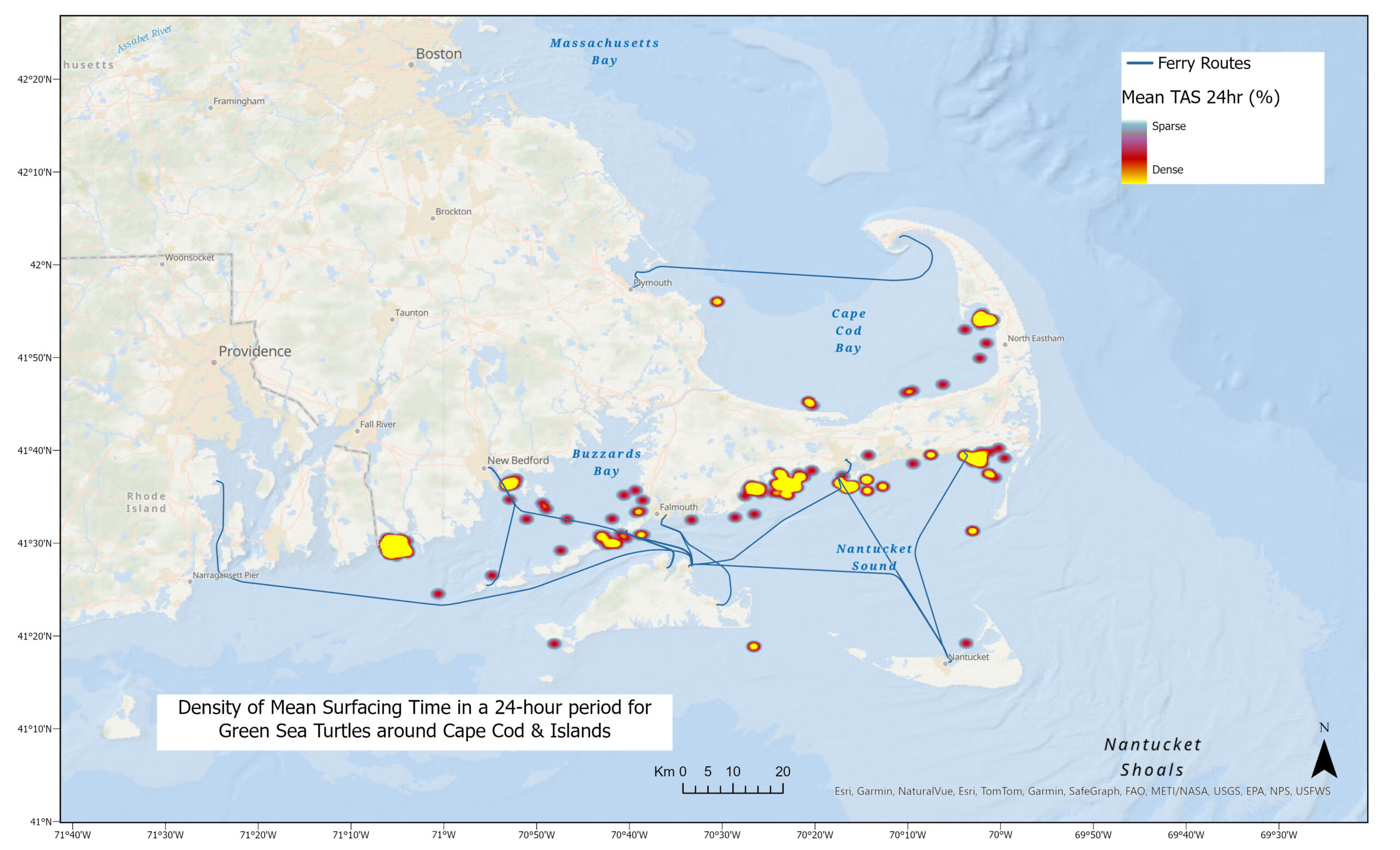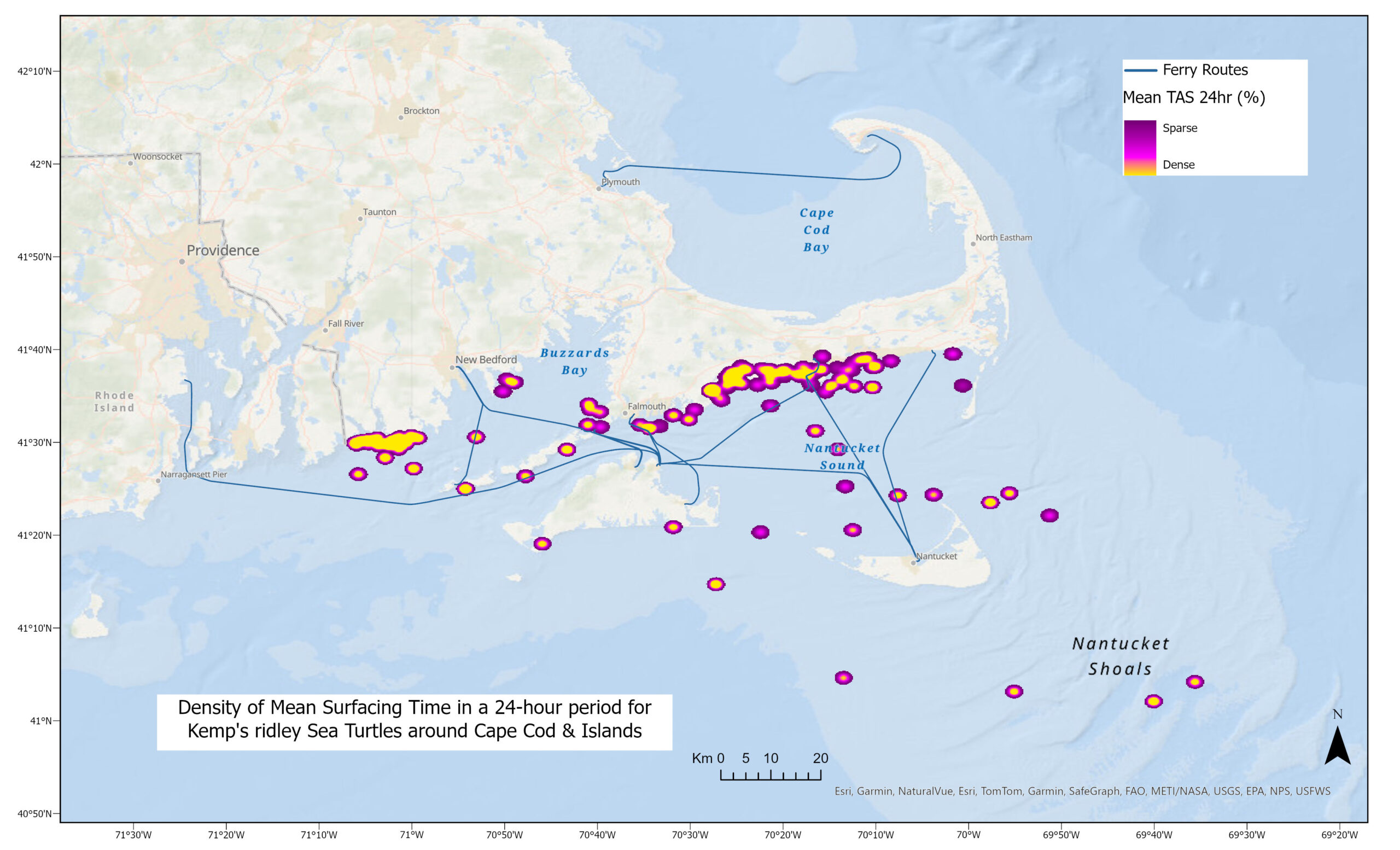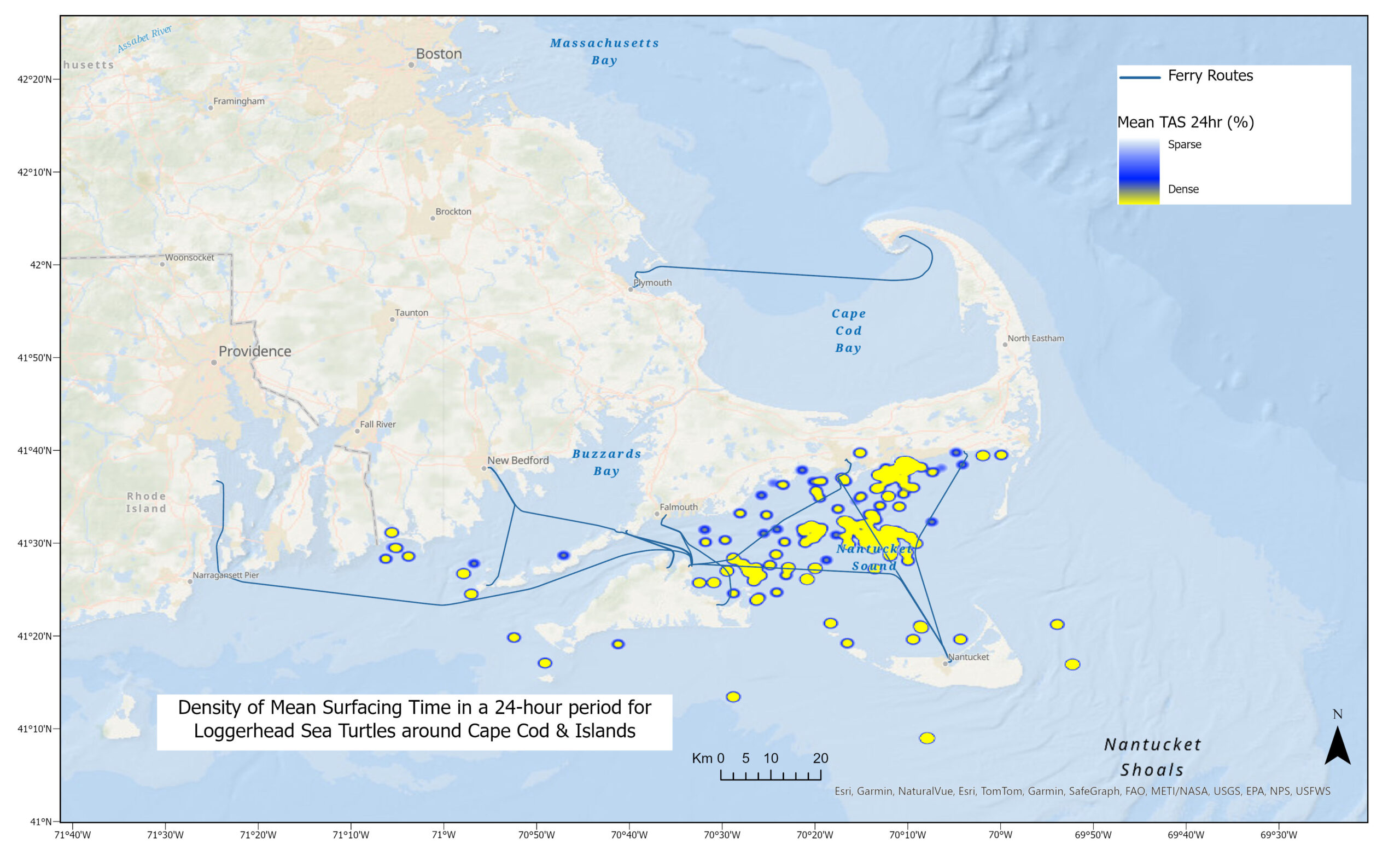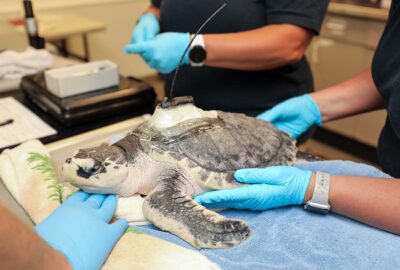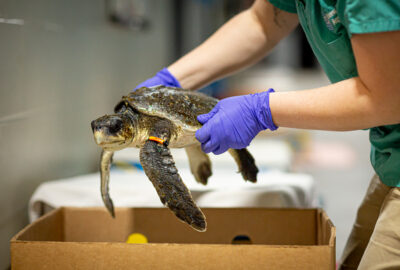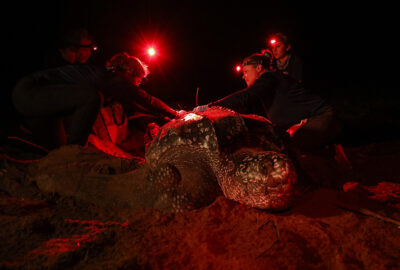Novel Research Investigates How a Sea Turtle’s Natural Behavior Leads to Risk for Human Interaction
Sea turtles must come to the surface of the water to breathe air, and this journey creates an undetermined level of vulnerability.
By New England Aquarium on Wednesday, April 23, 2025

By Kristen Luise, Senior Biologist
New England Aquarium Senior Biologist Kristen Luise and Dr. Kara Dodge, a research scientist in the Anderson Cabot Center for Ocean Life, are investigating the risk of vessel strikes for sea turtles in Massachusetts. Each summer and fall, four species of sea turtles, the loggerhead (Caretta caretta), green (Chelonia mydas), Kemp’s ridley (Lepidochelys kempii), and leatherback (Dermochelys coriacea), occupy foraging grounds within New England to search for prey such as crabs, mollusks, and jellyfish. As an air-breathing species, sea turtles must come to the surface of the water in order to recover from dives. Sea turtle presence coincides with an increase in boating activity and high vessel traffic off Cape Cod during the summer months, and it is crucial to acknowledge the potential vulnerabilities for turtle-vessel interactions.
The connection between how long sea turtles spend at the surface of the water and the resulting vulnerability to vessel strikes is novel research for this region. Scientists from various departments at the New England Aquarium, including Rescue and the Anderson Cabot Center for Ocean Life, have teamed up to investigate the percentage of time a sea turtle spends at the surface of the water around Cape Cod.
How is the data collected?

The Aquarium’s Sea Turtle Hospital admits an average of 400 sea turtles each winter that have been impacted by cold-stunning on Cape Cod. Following months of rehabilitation, surviving turtles are released in warmer months, often with a tag to monitor their behavior and survivorship after release. Some tagging methods, such as satellite telemetry, allow researchers to remotely study sea turtles upon their return back home. Useful information includes location, depth, and temperature, and, more importantly, in this case, how much time sea turtles are spending at the surface of the water.
Why Cape Cod?
Little is currently known about sea turtle surfacing behaviors around Cape Cod, and that is where the New England Aquarium comes in. For sea turtles in this region, primary threats from human interaction include entanglement in fishing gear and vessel strikes. There have been previous studies examining sea turtle surfacing behavior relative to human interaction in other areas of the US, but never on Cape Cod. In this area particularly, these threats to turtles increase during the summertime as the Cape is a popular tourist destination, resulting in a large influx of recreational and commercial boating activity. In the summer of 2024, there were 15
confirmed sea turtle mortalities as a result of vessel strike, and the fatalities included a mix of loggerhead and Kemp’s ridleys. Since most vessel-struck turtles are found washed up on the beach, the exact locations of these collisions are difficult to pinpoint, but the locations of the stranded turtles were often located adjacent to popular ferry routes.
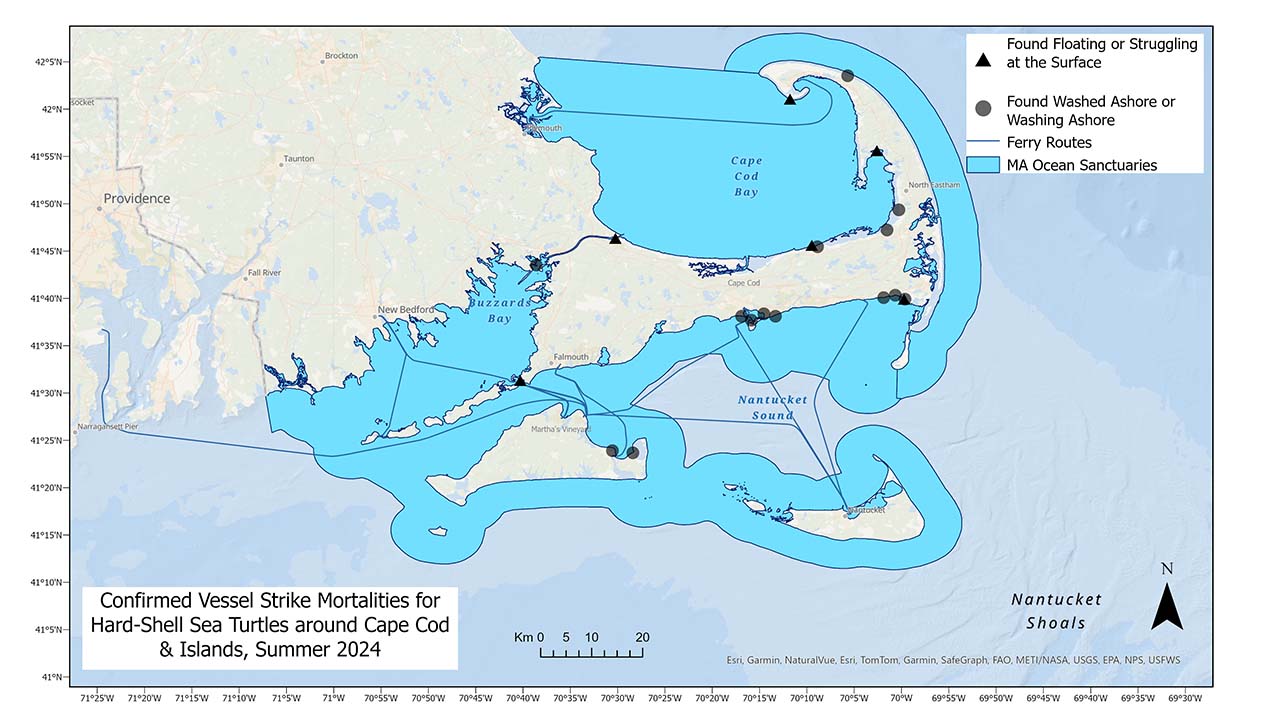
A quick but risky journey
From 2021-2023, a subset of the turtles rehabilitated at the Sea Turtle Hospital and released off Cape Cod received a satellite tag. These 27 satellite-tagged turtles included a mix of loggerheads, greens, and Kemp’s ridleys, and the tags provided information on surfacing time, location, and other environmental parameters. While this is an ongoing research project, results for Cape Cod thus far have shown that in a 24-hour period, Kemp’s ridley turtles spend an average of 2.19% of their time at the surface, green turtles spend an average of 1.01% of their time at the surface, and loggerhead turtles spend an average of 3.93% of their time at the surface. Locations of high density surfacing also appear to be more nearshore for Kemp’s ridleys and greens, and further offshore for loggerheads.
While these percent surface times may be considered low, this finding aligns with the concern for human interaction and the need for research projects such as this one. It is evident that sea turtles spend the majority of their time within the water column, only briefly coming up to the surface to breathe before diving. This quick surfacing time may reduce awareness that sea turtles are present and limit boaters from being on the lookout. As the saying goes, out of sight, out of mind. However, the stranding data has shown that while a short time is spent at the surface, the opportunity for human interaction is still a great threat. The New England Aquarium Rescue department and the Anderson Cabot Center for Ocean Life are continuing this research to learn more about surfacing behavior and how it may differ between species of sea turtles.
/
Why is this important?
In order to protect a species, it is important to first understand the biology of the target species. By gaining knowledge on sea turtle surfacing behavior and assessing how it may overlap with human activity, scientists can collaborate with the fishing community and develop effective conservation strategies benefiting all parties involved. These relationships are important to foster now more than ever, with sea turtles predicted to have a continued and growing presence in southern New England and the Gulf of Maine. In addition to understanding the potential for human interactions, time-at-surface data are also critical for developing “availability bias” corrections for sea turtle density and abundance estimates, since turtles must be at or close to the surface in order to be detected by aerial surveys.
How to report a sea turtle sighting
If you come across a sea turtle in Southern New England waters, our partners at Mass Audubon Wellfleet Bay Wildlife Sanctuary want to know! Report your sighting as soon as possible to seaturtleturtlesightings.org. If you are unable to report online, please call their hotline at 1-888-SEA-TURT (1-888-732-8878).

